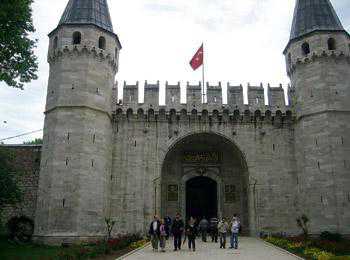Sheldon Kirshner, Staff Reporter, Monday, June 18, 2012

The entrance to Topkapi [Sheldon Kirshner photo]
ISTANBUL — In Jules Dassin’s 1964 feature film, Topkapi, the Greek actor Melina Mercouri plays a thief plotting to steal a priceless emerald-studded dagger from a glass case in the imperial treasury.
One can understand why this gold and green dagger, commissioned by Sultan Mahmud I in 1747 as a gift for the shah of Persia, was the object of her desire.
Glittering under artificial lighting, this exquisite piece never actually reached the shah. After the shah’s assassination, Mahmud I kept the dagger, depositing it in the imperial treasury, one of the buildings in the royal residence, known then and now as the Topkapi Palace.
Probably the premier tourist attraction in Istanbul today, Topkapi leaves memorable impressions.
Apart from having been the residence of Ottoman sultans from 1465 to 1856, Topkapi was the seat of government of the Ottoman Empire, which stretched into the Balkans and the Middle East, including Palestine, and officially lasted until 1922, when the sultanate was abolished.
Converted into a museum in 1924, a year after Turkey became the successor state of the far-flung empire, Topkapi, the jewel in Istanbul’s crown, is now administered by the ministry of culture and tourism, and has been a UNESCO World Heritage Site since 1985.
Built on a promontory with a splendid view of Istanbul, the Sea of Marmara and the Golden Horn, Topkapi was constructed in phases and rebuilt after an earthquake in 1509 and a fire in 1655.
Surrounded by a high wall, some of which dates back to the Byzantine era, Topkapi was really a city within a city, consisting of four courtyards and containing such buildings as mosques, bakeries, a mint, a harem and a hospital.
By the 17th century, Topkapi had lost some of its importance due to the decision by sultans to build palaces along the Bosphorus, the strategic strait that separates Europe from Asia. In 1856, when Sultan Abdul Mecid I moved the royal court to the Dolmabahce Palace, Topkapi became something of a white elephant.
At the suggestion of Ilber Ortayli, Topkapi’s president, I began my truncated tour at the imperial treasury, whose resplendent objects consist of spoils of war, gifts and special pieces produced by highly skilled craftsmen.
Of particular interest were 16th-century jewel-encrusted Persian flasks, a 19th-century jade piece presented to Sultan Abdulhamid II by the Russian czar in the 19th century, a 16th-century Ottoman helmet made of gold, turquoise and rubies, a 16th-century bowl of cut emeralds weighing 15 to 29 grams and an undated jewelry box sparkling with emeralds and rubies. Ottoman imperial thrones are also striking in appearance.
The 18th-century throne of Sultan Mustafa II was wheeled out a final time in 1918 when the last Ottoman sultan, Mehmed VI, was crowned.
The mid-16th-century ebony throne of the empire’s greatest sultan, Suleyman the Magnificent, stands as a testament to the power and influence of a Muslim empire.
The throne of Ahmed I (1603-1617) is unique, having been designed by Mimar Sinan, the architect of Istanbul’s glittering Blue Mosque.
Across a path from the imperial treasury is the Enderun Library, or Library of Ahmed III, a fine example of 18th-century Ottoman architecture.
Decorated with 16th- and 17th-century Iznik tiles, the building contained books on Islamic law and theology in Turkish, Arabic and Persian. Nowadays, these volumes are stored in a mosque.
Nearby is the Privy Chamber, which houses sacred Muslim relics, namely the cloak of the Prophet Muhammed, a hair of his beard and two of his swords, as well as oil paintings of Ottoman sultans from Osman II (1618-1622) to Abdulhamid II (1876-1909).
The Pavilion for Breaking the Fast, commissioned by Sultan Ibrahim (1640-1648 and used during the Ramadan holiday, is really a fancy terrace that offers views of Istanbul and the Sea of Marmara.
The adjacent Baghdad Pavilion, built to commemorate a successful military campaign by Sultan Murad IV in the 1600s, is regarded as an example of classical palace architecture.
Adorned with mother-of-pearl tiles, with tortoise shells decorating window panels, this structure served as a library from the 18th century onward.
As I arrived at Topkapi shortly before closing, I was unable to visit either the Portrait Gallery, whose collection of hand-painted Islamic miniatures may be unrivalled, or the harem, the private apartments of sultans, their wives, children, concubines and servants.
No one who has the time should miss these splendid sights.
via Topkapi Palace is the jewel in Istanbul’s crown | The Canadian Jewish News.

Leave a Reply